| |
| |
Photographer,
Location |
Images |
Comments |
|
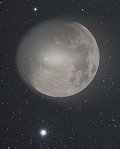
|
Günther Strauch,
Borken, NRW, Germany
Nov. 22, 2007 |
#1,
#2 |
Today the moon
was very bright. It was not easy to see the comet Holmes
with the necked eyes. So, I create one picture of the moon
and one of comet Holmes and create one out of two. Canon
EOS 20D, focus distance 100/1000 refractor and 80/600 refractor.
Moon 100 ASA/125 secondes, Comet Holmes 1600 ASA, 60 secondes
Kind regards Günther |
|
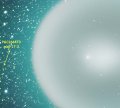
|
Bill
Williams,
Chiefland Astronomy Village, Florida
Nov. 9, 2007 |
#1,
#2, #3 |
"Comet
Holmes Swallows Star" - a mere snack! This comet consumed
a whole GALAXY, magnitude 17.2 PGC 166473 on Nov. 9, 2007
as seen in image #1.
This distant galaxy resides at a distance of 200 million
LIGHT YEARS shining feebly through the blue-green coma of
Holmes at a neighborly distance of about 200 million MILES!
Image #2
defines the field of image #1
(yellow box) when the tail detached approaching the star
34 Persei. Image #3
is a Sky Tools chart with Holmes' coma superimposed at the
time it transited the PGC galaxy. Images were taken with
6-inch Astro-Physics refractor and STL-11K CCD camera. |
|
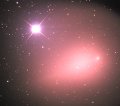
|
Martin Wagner,
Sonnenbuehl-Genkingen, Germany
Nov. 20, 2007 |
#1,
more |
I photographed with my 10" Newton, f=1300mm and a Canon EOS 300D with Baader H Alpha filter about 50x15s. It was on 20.11.2007 at about 2:00 UT.
|
|

|
Mila Zinkova,
San Francisco, California, USA
Nov. 22, 2007 |
#1, more |
The Moon or
not the Moon, but I simply cannot get enough from the amazing
comet. We were clouded out for many days before and now
the comet is fading, yet she is still bright enough to see
and to photograph her even with the Moon light and even
with 18 mm lens and it is what I'm doing every evening and
every morning.
|
|
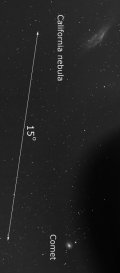
|
Michael Zolnowski-Tiamat,
Solaris Observatory
Nov. 22, 2007 |
#1,
more |
In a few weeks
Comet Holmes will start closing in on the California nebula,
one of the biggest deep sky objects in the northern hemisphere.
Now the comet is 15 degrees from this amazing nebula. In
March the comet will be passing very close to this object
but we don't know in what condition will be this strange
comet. This picture is made using H-alpha narrowband filter
and astrocamera. This is stack of five 30 minutes images.
|
|

|
Erno Berko,
Ludanyhalaszi, HUNGARY
Nov. 20, 2007 |
#1 |
Perseus and the Medusa.
The beautiful comet 17P near the Mirfak.
The sky is very bright (80% Moon). 19:00(UT)
The image made with 100mm/f6 refractor and
Canon 350D camera. 10x80sec in IRIS.
|
|

|
Gote Flodqvist,
Stockholm, Sweden
Nov. 21, 2007 |
#1,
more |
A sigh from history......
|
|

|
Jimmy Westlake,
Mt. Wilson near Pasadena, California USA
Nov. 18, 2007 |
#1,
#2, more |
The Colorado Mountain College SKY Club spent a night observing with the historic 60-inch Hale Telescope on Mt. Wilson Nov. 17-18, 2007. While the telescope was aimed at the Blue Snowball Nebula (NGC7662), I photographed the constellation Perseus and Comet Holmes through the open dome.
1) Fuji FinePix S2 digital camera at ISO 800, 16 mm Nikkor lens at f2.8, 15-second tripod mounted exposure.
2) Fuji FinePix S2 digital camera at ISO 800, 35 mm Nikkor lens at f3.3, 30-second tripod mounted exposure.
|
|
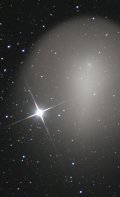
|
Jari Kankaanpää,
Kauhava, Finland
Nov. 19, 2007 |
#1,
more |
400mm IF-ED Nikkor 5,6 & Nikon D 80
Tracking: 12" Meade LX-200 telescope.
|
|
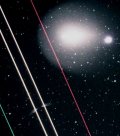
|
Michael Novak,
Commerce Township, Mi, USA
Nov. 18, 2007 |
#1 |
I finally got my shot set and this pesky plane flew through the FOV. Nice detail on the planes wings.
Canon 40D 30S ISO800
|
|
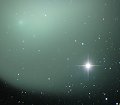
|
Richard McCoy,
Mead, Colorado
Nov. 19, 2007 |
#1,
more |
Holmes and Mirfak: An awesome sight!
Photo Details: Takahashi FSQ and SBIG ST-2000XM
|
|
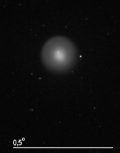
|
Pavol Rapavy,
Rimavska Sobota, Slovakia
Nov. 21, 2007 |
#1,
#2, more |
Morphing images comet 17P/Holmes between Nov.1 and Nov.21, CCD camera SHT 1.3, f=300 mm, crop
|
more
images (Nov. 20-21): from
Jan Timmermans of Valkenswaard, The Netherlands; from
Rick Baldridge of Oakridge Observatory, Los Gatos; from
Jan Koeman of Kloetinge, The Netherlands; from
Florin Marc of Tg.Mures, Romania; from
Claudio Pincelli of Holyoke, Mass.; from
Konstantinos Christodoulopoulos of Korinth, Greece;
more
images (Nov. 18-19): from
Dave Jurasevich of Mount Wilson Observatory, Mount Wilson,
CA; from
Rembert Melman of Dieren, Netherlands; from
Manuel Cabrera of Mina N.L. México; from
Dale J Martin of Lunenburg, MA; from
Andres Posada of Medellin, Colombia;
more
images (Nov. 16-17):
from
Chiara Riedo of Mottarone, Novara, Italy; from
Tom Teters of Ft. Collins, Colorado; from
Lynn van Rooijen of North Holland, Netherlands;
more
images (Nov. 14-15):
from
Denis Goyette of Fort El Kantoui, Tunisia;
|
|